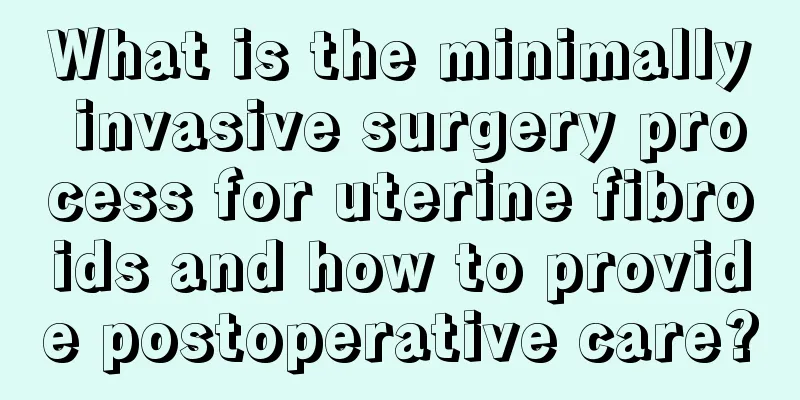What is the minimally invasive surgery process for uterine fibroids and how to provide postoperative care?

|
Speaking of uterine fibroids, I believe some women are not unfamiliar with it. It is a common gynecological disease in women clinically. With the development of medical technology, there are more and more methods to treat uterine fibroids. However, in recent years, minimally invasive surgery has been recognized by more and more patients. So today I will talk about the process of minimally invasive surgery and how to care after the surgery! If you have any questions, you can take a look together. There are many surgical methods for treating uterine fibroids. Here is an introduction to the specific process of one of these methods - minimally invasive treatment: The main minimally invasive treatment procedure is uterine artery embolization (UAE). UAE involves cutting a small hole the size of a grain of rice at the base of one thigh, inserting a special catheter into the blood supply artery of the uterine fibroids, and using embolic agents to block the blood supply to the fibroids, thereby achieving the goal of "starving" the fibroids to death. The operation takes a short time and can be completed in as fast as 30 minutes, and usually in about 1 hour. It is done under anesthesia, so the procedure is painless. The postoperative reaction is relatively mild, mainly manifested as mild and short-term pain in the lower abdomen and low fever. This is a normal reaction after surgery and can be cured after symptomatic treatment. The following methods should be followed for care after minimally invasive surgery for uterine fibroids: 1. Timely review After being diagnosed with uterine fibroids, women should have regular check-ups and take timely treatment measures based on the progression of the disease. 2. Balanced diet and proper nutrition Patients should adjust their diet structure, adhere to a low-fat diet, eat more whole grains, eat more fresh vegetables and fruits, and avoid eating high-fat and spicy foods to reduce the occurrence of uterine fibroids. 3. Actively practice contraception and pay attention to menstrual health care Abortion may damage the cervix or uterus and increase a woman's risk of developing uterine fibroids. Therefore, women should take good contraceptive measures in their daily lives and reduce the number of abortions, thereby reducing the incidence of uterine fibroids. After reading the above description by the editor, I believe you now have a certain understanding of the process of minimally invasive surgery for uterine fibroids. Although medical technology is developing rapidly now, surgical operations are becoming more and more sophisticated. However, in order to completely cure the disease, postoperative care cannot be ignored. Therefore, it is recommended that patients and their families pay attention to all postoperative care and strive for a speedy recovery. |
<<: What are some ways for women to increase their immunity?
>>: How to treat mild mastitis?
Recommend
What causes itchy nipples?
Women are naturally very careful, but because the...
IDC: China's smartphone market shipments in the third quarter of 2021 were approximately 80.8 million units, a year-on-year decrease of 4.7%
According to the latest IDC mobile quarterly trac...
Delayed menstruation with a little bloodshot pregnancy
Menstruation is what we often call period. It is ...
Causes of Endometrial Fibrosis
Endometrial fibrosis is a gynecological disease t...
Symptoms of tubal pregnancy
Pregnancy is a happy thing for many people, and a...
Can pregnant women eat pickles?
Pregnant women have many things to pay attention ...
Can I take Sanjiu Ganmao Ling Granules during breastfeeding?
The principle of taking medicine during breastfee...
What are the taboos of confinement?
After giving birth, Chinese women have to observe...
Just after drying the quilt, the person was sent to the hospital? This inconspicuous "little action" is so dangerous
The temperature has dropped sharply in the past f...
What causes bloating in pregnant women?
As we all know, if we eat indigestible foods like...
Can I use a slimming pack during my period?
Girls will pay special attention and be careful d...
Can eyeliner tattoos be completely washed off?
In order to save the trouble of putting on makeup...
What medicine should women use for itchy clitoral head
Many female friends have unspeakable pain, the un...









